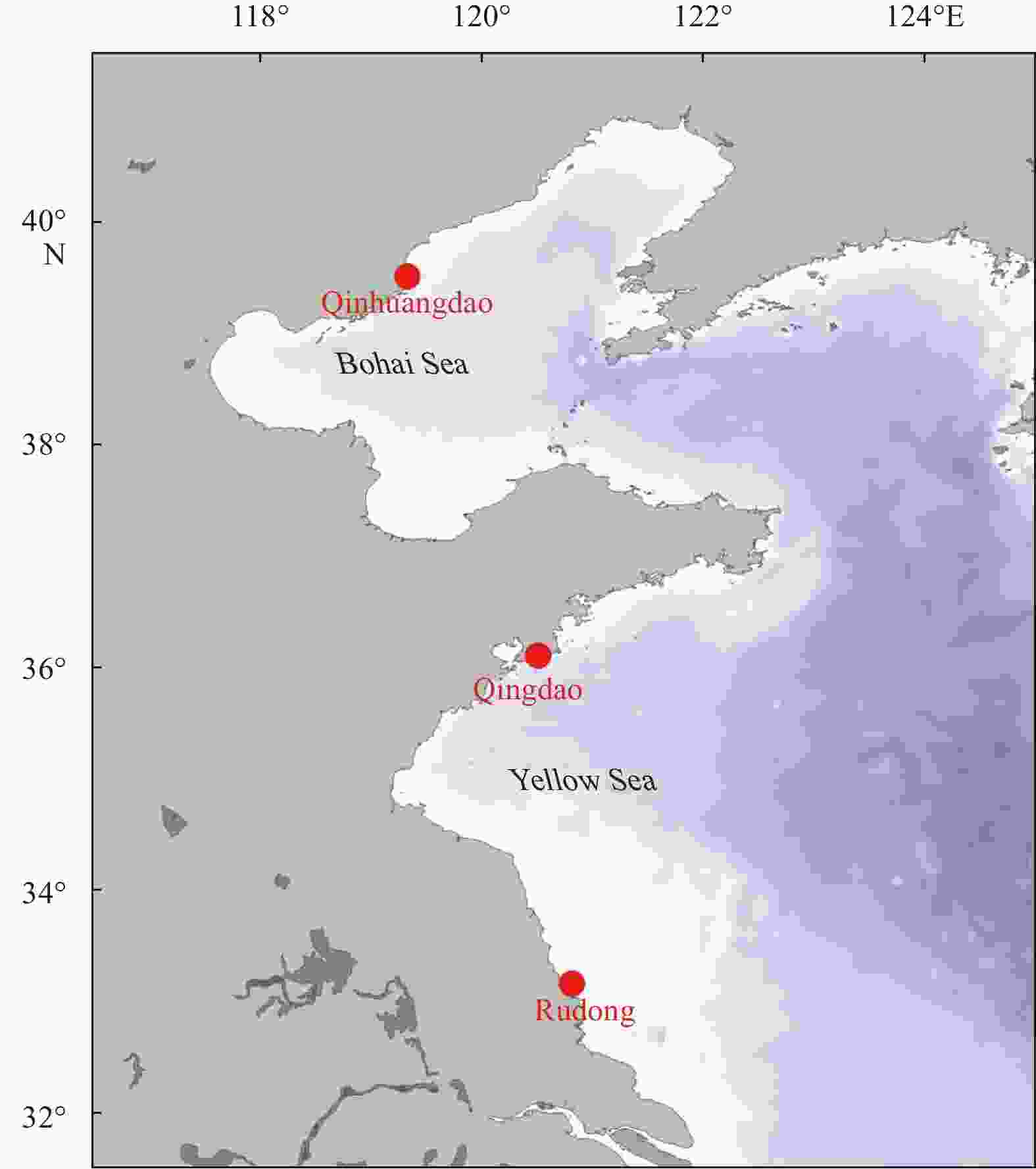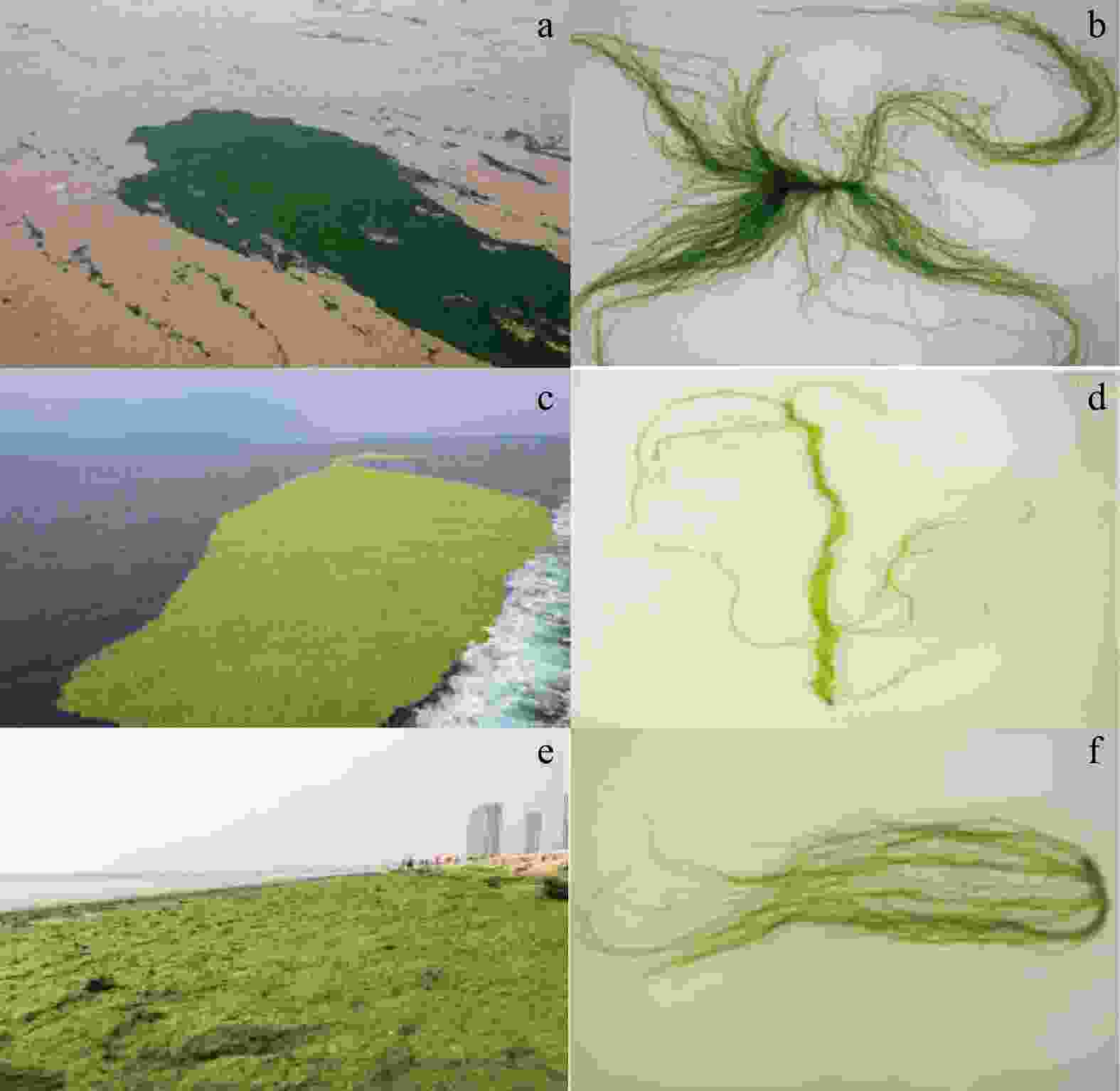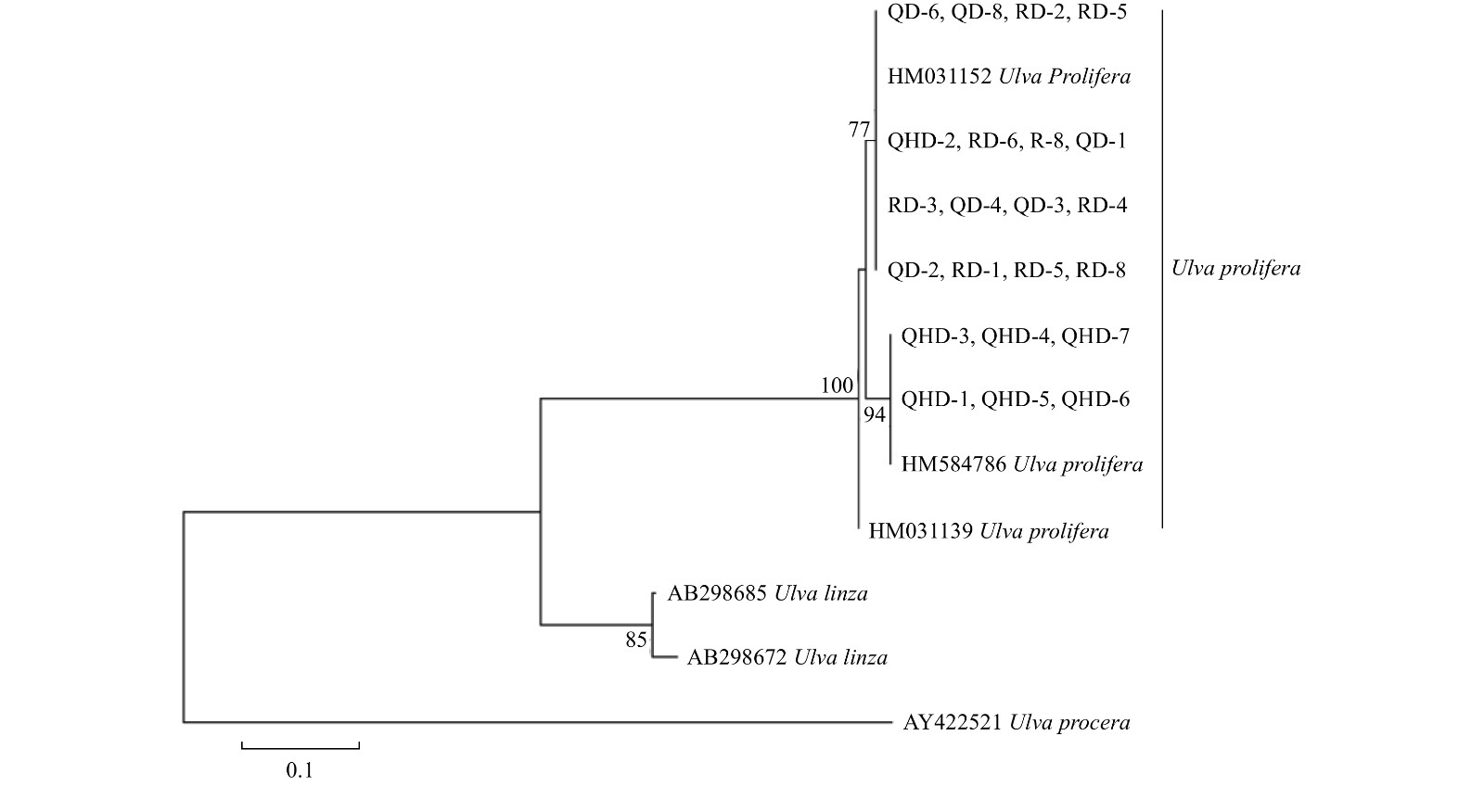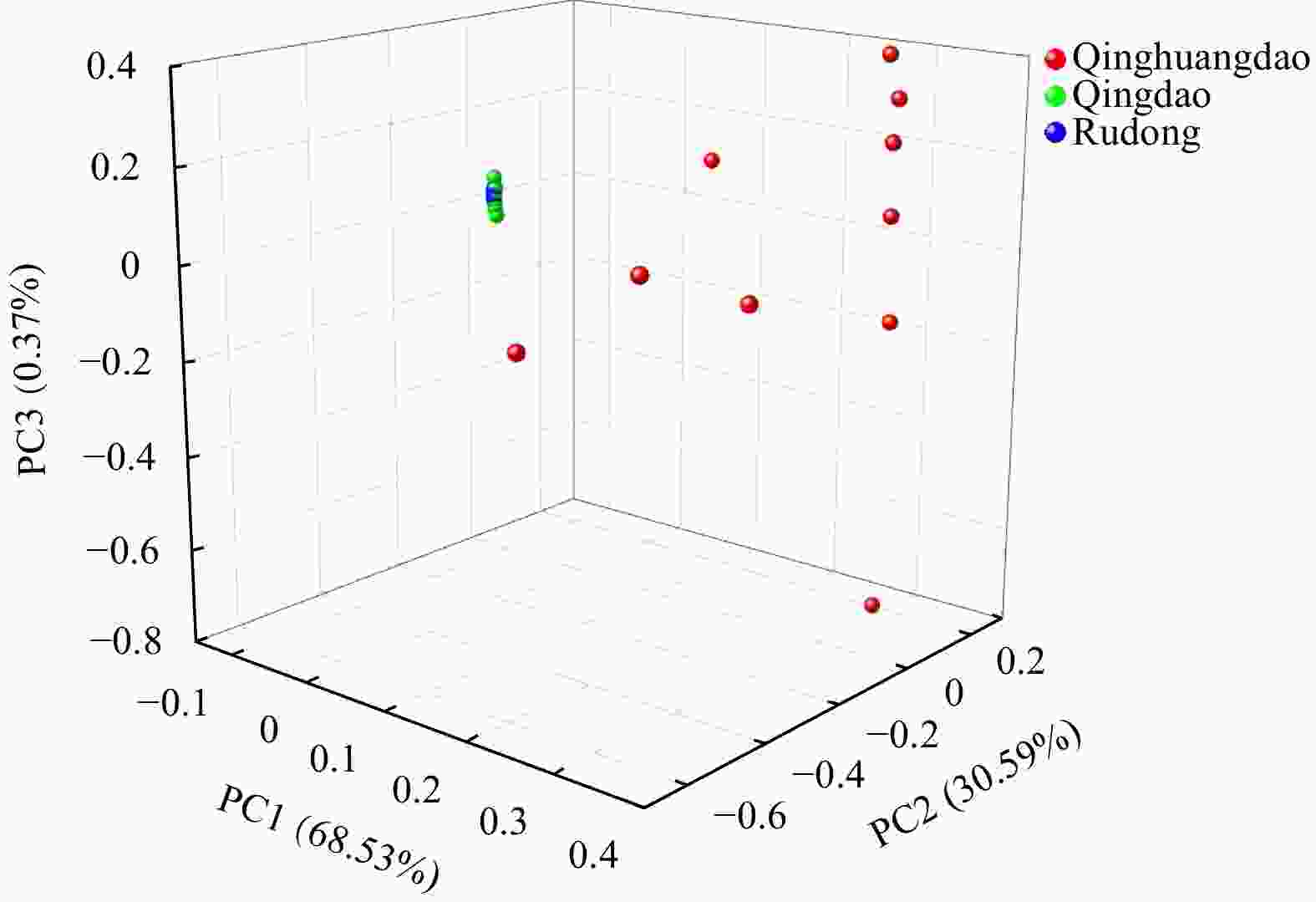Population differentiation in the dominant species (Ulva prolifera) of green tide in coastal waters of China
-
Abstract: Since 2015, green tides with Ulva prolifera as the dominant species in the Qinhuangdao coastal waters have continued to occur. In this study, the relationship between green tides in Qinhuangdao and the Yellow Sea (setting sites in Rudong and Qingdao) was evaluated by genetic analyses of U. prolifera. Single nucleotide polymorphism (SNP) markers were used to analyze genetic diversity and genetic relationships among groups. Genetic differentiation was lower among floating U. prolifera populations in Rudong and Qingdao than in Qinhuangdao. The floating U. prolifera population had higher genetic diversity and polymorphism levels in Qingdao and Rudong than in Qinhuangdao. Physiological experiments showed that the growth rate and net buoyancy of floating U. prolifera were highest in Qinhuangdao and Qingdao, respectively, under the same environmental conditions (temperature and light). Overall, these findings showed that U. prolifera populations in the Qinhuangdao and Yellow Sea green tides (Rudong and Qingdao) differ significantly at the molecular and physiological levels. Therefore, the Qinhuangdao green tide is not correlated with the Yellow Sea green tide and has a different origin and development mode. This study provides insight into the mechanism underlying green tide blooms in coastal waters of China.
-
Key words:
- Ulva prolifera /
- green tide /
- dominant species /
- population differentiation /
- Qinhuangdao
-
Table 1. Sample information
Location Sample number Collection date Rudong RD-1, RD-2, RD-3, RD-4, RD-5, RD-6,
RD-7, RD-8, RD-9, RD-10May 21, 2019 Qingdao QD-1, QD-2, QD-3, QD-4, QD-5, QD-6,
QD-7, QD-8, QD-9, QD-10June 24, 2019 Qinhuangdao QHD-1, QHD-2, QHD-3, QHD-4,
QHD-5, QHD-6, QHD-7, QHD-8,
QHD-9, QHD-10July 18, 2019 Table 2. Genetic diversity in three Ulva prolifera populations
Population He Ho PIC Qinhuangdao range 0–0.54 0–0.89 0–0.47 average value 0.11 0.16 0.07 Qingdao range 0–0.50 0–1 0–0.38 average value 0.16 0.26 0.17 Rudong range 0–0.50 0–1 0–0.38 average value 0.14 0.21 0.15 Note: PIC is the abbreviation of polymorphism information content. -
Blomster J, Back S, Fewer D P, et al. 2002. Novel morphology in Enteromorpha (Ulvophyceae) forming green tides. American Journal of Botany, 89(11): 1756–1763. doi: 10.3732/ajb.89.11.1756 Collins C J, Fraser C I, Ashcroft A, et al. 2010. Asymmetric dispersal of southern bull-kelp (Durvillaea antarctica) adults in coastal New Zealand: testing an oceanographic hypothesis. Molecular Ecology, 19(20): 4572–4580. doi: 10.1111/J.1365-294X.2010.04842.X Cui Jianjun, Zhang Jianheng, Huo Yuanzi, et al. 2015. Adaptability of free-floating green tide algae in the Yellow Sea to variable temperature and light intensity. Marine Pollution Bulletin, 101(2): 660–666. doi: 10.1016/j.marpolbul.2015.10.033 Cui Jianjun, Zhang Jianheng, Monotilla A P, et al. 2019. Assessment of blooming Ulva macroalgae production potential in the Yellow Sea, China. Phycologia, 58(5): 535–541. doi: 10.1080/00318884.2018.1551016 Ding Lanping, Luan Rixiao, Huang Bingxin, et al. 2008. The taxonomical study on Capsosiphonaceae (Ulvales, Chlorophyta) from Huanghai-Bohai Seas of China. Haiyang Xuebao (in Chinese), 30(2): 169–174 Duan Weijun, Guo Lixin, Sun Dong, et al. 2012. Morphological and molecular characterization of free-floating and attached green macroalgae Ulva spp. in the Yellow Sea of China. Journal of Applied Phycology, 24(1): 97–108. doi: 10.1007/s10811-011-9654-7 Fan Shiliang, Fu Mingzhu, Li Yan, et al. 2012. Origin and development of Huanghai (Yellow) Sea green-tides in 2009 and 2010. Haiyang Xuebao (in Chinese), 34(6): 187–194 Fan Shiliang, Fu Mingzhu, Wang Zongling, et al. 2015. Temporal variation of green macroalgal assemblage on Porphyra aquaculture rafts in the Subei Shoal, China. Estuarine, Coastal and Shelf Science, 163: 23–28, Fu Xiaoteng, Dou Jinzhuang, Mao Junxia, et al. 2013. RADtyping: an integrated package for accurate de novo codominant and dominant RAD genotyping in mapping populations. PLoS ONE, 8(11): e79960. doi: 10.1371/journal.pone.0079960 Fu Mingzhu, Fan Shiliang, Wang Zongling, et al. 2019. Buoyancy potential of dominant green macroalgal species in the Yellow Sea’s green tides, China. Marine Pollution Bulletin, 140: 301–307. doi: 10.1016/j.marpolbul.2019.01.056 Gao Guang, Zhong Zhihai, Zhou Xianghong, et al. 2016. Changes in morphological plasticity of Ulva prolifera under different environmental conditions: a laboratory experiment. Harmful Algae, 59: 51–58. doi: 10.1016/j.hal.2016.09.004 Han Wei, Chen Liping, Zhang Jianheng, et al. 2013. Seasonal variation of dominant free-floating and attached Ulva species in Rudong coastal area, China. Harmful Algae, 28: 46–54. doi: 10.1016/j.hal.2013.05.018 Han Hongbin, Fan Shiliang, Song Wei, et al. 2020. The contribution of attached Ulva prolifera on Pyropia aquaculture rafts to green tides in the Yellow Sea. Acta Oceanologica Sinica, 39(2): 101–106. doi: 10.1007/s13131-019-1452-0 Han Hongbin, Song Wei, Wang Zongling, et al. 2019. Distribution of green algae micro-propagules and their function in the formation of the green tides in the coast of Qinhuangdao, the Bohai Sea, China. Acta Oceanologica Sinica, 38(8): 72–77. doi: 10.1007/s13131-018-1278-1 Huo Yuanzi, Han Hongbin, Shi Honghua, et al. 2015. Changes to the biomass and species composition of Ulva sp. on Porphyra aquaculture rafts, along the coastal radial sandbank of the southern Yellow Sea. Marine Pollution Bulletin, 93(1–2): 210–216, Huo Yuanzi, Hua Liang, Wu Hailong, et al. 2014. Abundance and distribution of Ulva microscopic propagules associated with a green tide in the southern coast of the Yellow Sea. Harmful Algae, 39: 357–364. doi: 10.1016/j.hal.2014.09.008 Largo D B, Sembrano J, Hiraoka M, et al. 2004. Taxonomic and ecological profile of ‘green tide’ species of Ulva (Ulvales, Chlorophyta) in central Philippines. Hydrobiologia, 512(1): 247–253. doi: 10.1023/B:HYDR.0000020333.33039.4B Lin Apeng, Shen Songdong, Wang Guangce, et al. 2011. Comparison of chlorophyll and photosynthesis parameters of floating and attached Ulva prolifera. Journal of Integrative Plant Biology, 53(1): 25–34. doi: 10.1111/j.1744-7909.2010.01002.x Liu Dongyan, Keesing J K, Xing Qianguo, et al. 2009. World’s largest macroalgal bloom caused by expansion of seaweed aquaculture in China. Marine Pollution Bulletin, 58(6): 888–895. doi: 10.1016/j.marpolbul.2009.01.013 Liu Jinlin, Xia Jing, Zhuang Minmin, et al. 2021. Controlling the source of green tides in the Yellow Sea: NaClO treatment of Ulva attached on Pyropia aquaculture rafts. Aquaculture, 535: 736378. doi: 10.1016/J.AQUACULTURE.2021.736378 Song Wei, Han Hongbin, Wang Zongling, et al. 2019a. Molecular identification of the macroalgae that cause green tides in the Bohai Sea, China. Aquatic Botany, 156: 38–46. doi: 10.1016/j.aquabot.2019.04.004 Song Wei, Peng Keqin, Xiao Jie, et al. 2015. Effects of temperature on the germination of green algae micro-propagules in coastal waters of the Subei Shoal, China. Estuarine, Coastal and Shelf Science, 163: 63–68, Song Wei, Wang Zongling, Li Yan, et al. 2019b. Tracking the original source of the green tides in the Bohai Sea, China. Estuarine, Coastal and Shelf Science, 219: 354–362, Taylor R, Fletcher R L, Raven J A. 2001. Preliminary studies on the growth of selected ‘green tide’ algae in laboratory culture: effects of irradiance, temperature, salinity and nutrients on growth rate. Botanica Marina, 44(4): 327–336. doi: 10.1515/BOT.2001.042 Van Inghelandt D, Melchinger A E, Lebreton C, et al. 2010. Population structure and genetic diversity in a commercial maize breeding program assessed with SSR and SNP markers. Theoretical and Applied Genetics, 120(7): 1289–1299. doi: 10.1007/s00122-009-1256-2 Wang Shiying, Huo Yuanzi, Zhang Jianheng, et al. 2018. Variations of dominant free-floating Ulva species in the source area for the world’s largest macroalgal blooms, China: differences of ecological tolerance. Harmful Algae, 74: 58–66. doi: 10.1016/j.hal.2018.03.007 Wang Yu, Liu Feng, Liu Xingfeng, et al. 2019. Comparative transcriptome analysis of four co-occurring Ulva species for understanding the dominance of Ulva prolifera in the Yellow Sea green tides. Journal of Applied Phycology, 31(5): 3303–3316. doi: 10.1007/s10811-019-01810-z Wang Shi, Liu Pingping, Lv Jia, et al. 2016. Serial sequencing of isolength RAD tags for cost-efficient genome-wide profiling of genetic and epigenetic variations. Nature Protocols, 11(11): 2189–2200. doi: 10.1038/nprot.2016.133 Wang Zongling, Xiao Jie, Fan Shiliang, et al. 2015. Who made the world’s largest green tide in China?—An integrated study on the initiation and early development of the green tide in Yellow Sea. Limnology and Oceanography, 60(4): 1105–1117. doi: 10.1002/lno.10083 Xu Zhiguang, Wu Haiyi, Zhan Dongmei, et al. 2014. Combined effects of light intensity and NH4+-enrichment on growth, pigmentation, and photosynthetic performance of Ulva prolifera (Chlorophyta). Chinese Journal of Oceanology and Limnology, 32(5): 1016–1023. doi: 10.1007/s00343-014-3332-y Zhang Jianheng, Huo Yuanzi, Zhang Zhenglong, et al. 2013. Variations of morphology and photosynthetic performances of Ulva prolifera during the whole green tide blooming process in the Yellow Sea. Marine Environmental Research, 92: 35–42. doi: 10.1016/j.marenvres.2013.08.009 Zhang Qingchun, Yu Rencheng, Chen Zhenfan, et al. 2018. Genetic evidence in tracking the origin of Ulva prolifera blooms in the Yellow Sea, China. Harmful Algae, 78: 86–94. doi: 10.1016/j.hal.2018.08.002 Zhao Jin, Jiang Peng, Liu Zhengyi, et al. 2013. The Yellow Sea green tides were dominated by one species, Ulva (Enteromorpha) prolifera, from 2007 to 2011. Chinese Science Bulletin, 58(19): 2298–2302. doi: 10.1007/s11434-012-5441-3 Zhao Jin, Jiang Peng, Qin Song, et al. 2015. Genetic analyses of floating Ulva prolifera in the Yellow Sea suggest a unique ecotype. Estuarine, Coastal and Shelf Science, 163: 96–102, -





 下载:
下载:










